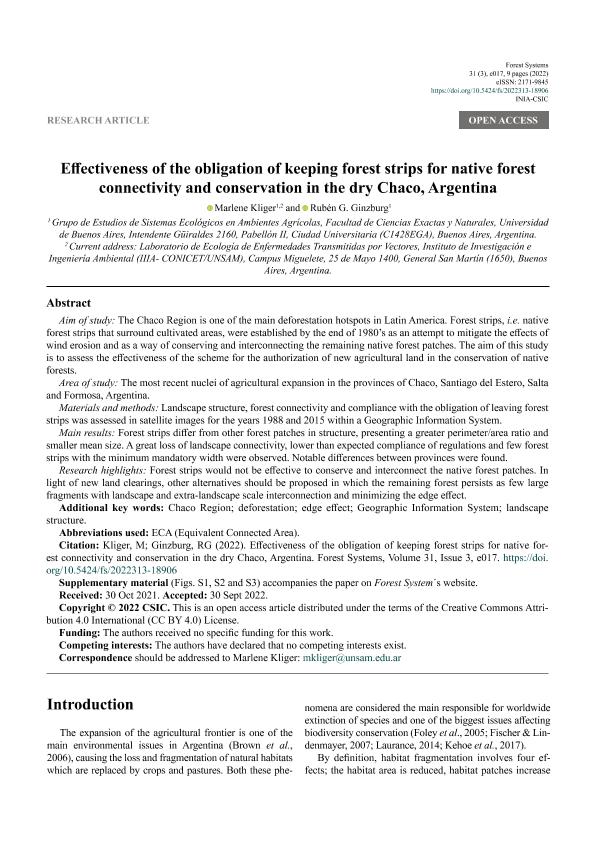Mostrar el registro sencillo del ítem
dc.contributor.author
Kliger, Marlene

dc.contributor.author
Ginzburg, Rubén Gabriel

dc.date.available
2023-07-18T14:07:46Z
dc.date.issued
2022-11
dc.identifier.citation
Kliger, Marlene; Ginzburg, Rubén Gabriel; Effectiveness of the obligation of keeping forest strips for native forest connectivity and conservation in the dry Chaco, Argentina; Consejo Superior de Investigaciones Científicas; Forest Systems; 31; 3; 11-2022; 1-9
dc.identifier.issn
2171-9845
dc.identifier.uri
http://hdl.handle.net/11336/204279
dc.description.abstract
Aim of study: The Chaco Region is one of the main deforestation hotspots in Latin America. Forest strips, i.e. native forest strips that surround cultivated areas, were established by the end of 1980’s as an attempt to mitigate the effects of wind erosion and as a way of conserving and interconnecting the remaining native forest patches. The aim of this study is to assess the effectiveness of the scheme for the authorization of new agricultural land in the conservation of native forests. Area of study: The most recent nuclei of agricultural expansion in the provinces of Chaco, Santiago del Estero, Salta and Formosa, Argentina. Materials and methods: Landscape structure, forest connectivity and compliance with the obligation of leaving forest strips was assessed in satellite images for the years 1988 and 2015 within a Geographic Information System. Main results: Forest strips differ from other forest patches in structure, presenting a greater perimeter/area ratio and smaller mean size. A great loss of landscape connectivity, lower than expected compliance of regulations and few forest strips with the minimum mandatory width were observed. Notable differences between provinces were found. Research highlights: Forest strips would not be effective to conserve and interconnect the native forest patches. In light of new land clearings, other alternatives should be proposed in which the remaining forest persists as few large fragments with landscape and extra-landscape scale interconnection and minimizing the edge effect.
dc.format
application/pdf
dc.language.iso
eng
dc.publisher
Consejo Superior de Investigaciones Científicas

dc.rights
info:eu-repo/semantics/openAccess
dc.rights.uri
https://creativecommons.org/licenses/by/2.5/ar/
dc.subject
CHACO REGION
dc.subject
DEFORESTATION
dc.subject
EDGE EFFECT
dc.subject
GEOGRAPHIC INFORMATION SYSTEM
dc.subject
LANDSCAPE STRUCTURE
dc.subject.classification
Ecología

dc.subject.classification
Ciencias Biológicas

dc.subject.classification
CIENCIAS NATURALES Y EXACTAS

dc.title
Effectiveness of the obligation of keeping forest strips for native forest connectivity and conservation in the dry Chaco, Argentina
dc.type
info:eu-repo/semantics/article
dc.type
info:ar-repo/semantics/artículo
dc.type
info:eu-repo/semantics/publishedVersion
dc.date.updated
2023-06-30T12:29:33Z
dc.journal.volume
31
dc.journal.number
3
dc.journal.pagination
1-9
dc.journal.pais
España

dc.journal.ciudad
Madrid
dc.description.fil
Fil: Kliger, Marlene. Universidad Nacional de San Martín. Instituto de Investigación e Ingeniería Ambiental. - Consejo Nacional de Investigaciones Científicas y Técnicas. Oficina de Coordinación Administrativa Parque Centenario. Instituto de Investigación e Ingeniería Ambiental; Argentina
dc.description.fil
Fil: Ginzburg, Rubén Gabriel. Universidad de Buenos Aires; Argentina
dc.journal.title
Forest Systems
dc.relation.alternativeid
info:eu-repo/semantics/altIdentifier/doi/http://dx.doi.org/10.5424/fs/2022313-18906
dc.relation.alternativeid
info:eu-repo/semantics/altIdentifier/url/https://revistas.inia.es/index.php/fs/article/view/18906
Archivos asociados
